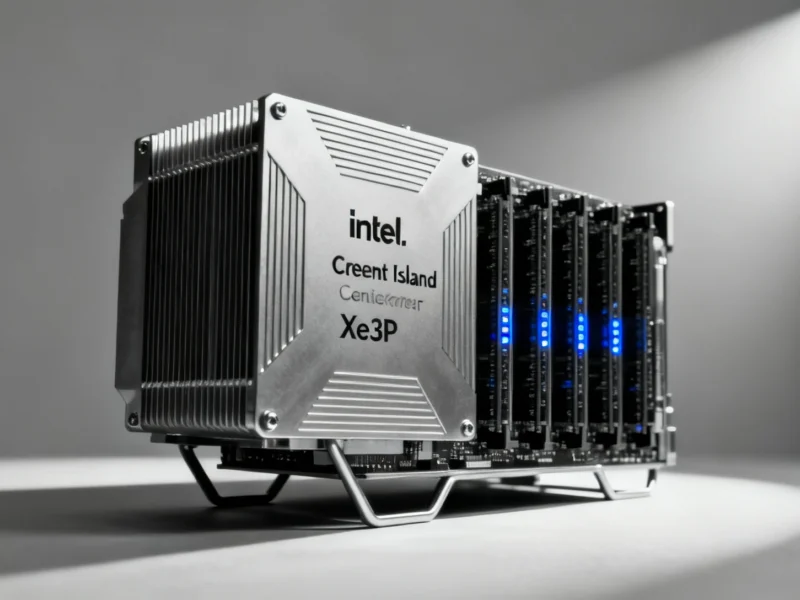Intel has officially unveiled its Crescent Island data center GPU, a specialized AI accelerator designed specifically for inference workloads in enterprise and cloud environments. The announcement came during the 2025 OCP Global Summit, where Intel executives emphasized the GPU’s high memory capacity and energy-efficient performance characteristics that position it as a competitive offering in the rapidly evolving AI hardware landscape.
Crescent Island Technical Specifications and Architecture
The new GPU will be built upon Intel’s forthcoming Xe3P architecture, which represents a performance-optimized variant of the company’s Xe3 GPU architecture currently featured in Panther Lake mobile processors. This architectural foundation enables Crescent Island to deliver substantial computational capabilities while maintaining power efficiency. The accelerator will feature an impressive 160GB of LPDDR5X memory, providing the high memory capacity necessary for handling large AI models and complex inference workloads.
Intel has specifically designed Crescent Island as “power- and cost-optimized” for air-cooled enterprise servers, making it accessible for organizations without specialized liquid cooling infrastructure. The GPU will support a broad range of data types, enhancing its versatility across various AI applications and use cases. This flexibility makes it particularly suitable for emerging business models like “tokens-as-a-service” providers who require efficient inference capabilities at scale.
Intel’s Strategic Vision for AI Inference
Sachin Katti, Chief Technology Officer of Intel, articulated the company’s perspective on the shifting AI landscape during the announcement. “AI is shifting from static training to real-time, everywhere inference – driven by agentic AI,” Katti stated. “Scaling these complex workloads requires heterogeneous systems that match the right silicon to the right task, powered by an open software stack. Intel’s Xe architecture data center GPU will provide the efficient headroom customers need – and more value – as token volumes surge.”
This vision reflects Intel’s recognition that the AI market is evolving beyond training-intensive applications toward inference-dominated workloads that require different architectural approaches. The company’s emphasis on heterogeneous systems acknowledges that no single processor type can optimally handle all AI workloads, necessitating specialized accelerators like Crescent Island for specific tasks.
Development Timeline and Software Ecosystem
Intel expects to provide customer samples of the Crescent Island data center GPU in the second half of 2026, indicating a substantial development and validation period ahead. In the interim, the company is actively developing and testing what it describes as an “open and unified software stack for heterogeneous AI systems” on its current Arc Pro B-Series GPUs. This approach aims to enable early optimizations and iterations, ensuring that when Crescent Island becomes available, it will be supported by mature software tools and frameworks.
The software development strategy underscores Intel’s commitment to creating a comprehensive ecosystem around its AI accelerators, recognizing that hardware capabilities alone are insufficient without robust software support. This parallel development of hardware and software reflects lessons learned from previous product launches and competitive dynamics in the AI accelerator market.
Market Context and Competitive Positioning
Crescent Island represents Intel’s renewed effort to establish meaningful presence in the AI accelerator space following the mixed performance of its Gaudi offerings. The company unveiled Gaudi 3 AI accelerator in April 2024, but during Intel’s Q3 2024 earnings call, former CEO Pat Gelsinger acknowledged that uptake had been slower than anticipated. Intel failed to meet its target of $500 million in revenue for Gaudi in 2024, highlighting the challenges of competing against established players like AMD and Nvidia.
The AI hardware market continues to evolve rapidly, with significant global implications. Recent developments such as DHS reports about criminal organizations exploiting technology ecosystems and India’s expanding trade deficit underscore the strategic importance of domestic semiconductor capabilities. Meanwhile, regulatory environments are also shifting, as indicated by European efforts to streamline technology regulations and global power exchange expansions that could impact data center operations.
Broader Data Center Strategy and Future Roadmap
Beyond Crescent Island, Intel is developing a rack-scale solution codenamed Jaguar Shores to address the broader AI data center market. This initiative follows the cancellation of Falcon Shores earlier this year, which interim CEO Michelle Johnston Holthaus explained was necessary to simplify Intel’s roadmap and concentrate resources. Holthaus, who has since left the company, acknowledged that while Intel maintains a “leading position as the host CPU for AI servers,” the company was “not yet participating in the cloud-based AI data center market in a meaningful way.”
The name Crescent Island continues Intel’s tradition of using geographical codenames for its products, though the company has not provided specific reasoning for this particular choice. The focus on inference workloads reflects market recognition that while training receives significant attention, inference represents the larger portion of AI computational demand in production environments.
Industry Implications and Potential Impact
The introduction of Crescent Island comes at a critical juncture in the AI hardware market, as organizations seek more specialized and efficient solutions for deploying AI at scale. By targeting inference workloads specifically, Intel is addressing a segment where performance per watt and total cost of ownership are paramount concerns for enterprise customers. The GPU’s design for air-cooled servers positions it well for broader adoption beyond hyperscale data centers, potentially expanding the market for dedicated AI accelerators.
As AI continues to permeate various industries and applications, the demand for efficient inference capabilities is expected to grow exponentially. Intel’s focus on this segment with Crescent Island represents a strategic bet that specialization and optimization for specific workload types will become increasingly important in the competitive landscape for AI hardware.




3 thoughts on “Intel Crescent Island GPU: New Data Center AI Accelerator for Inference Workloads”